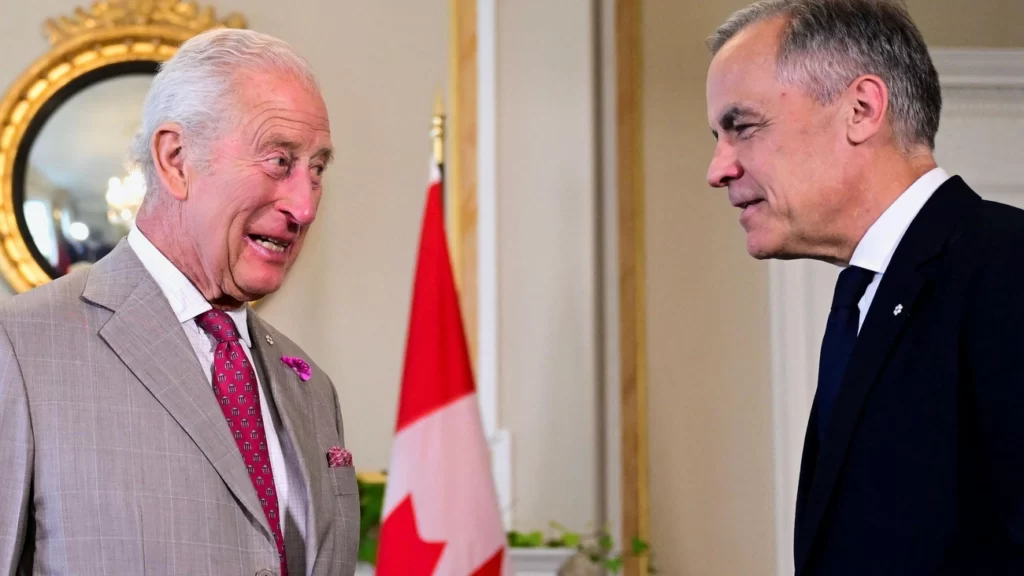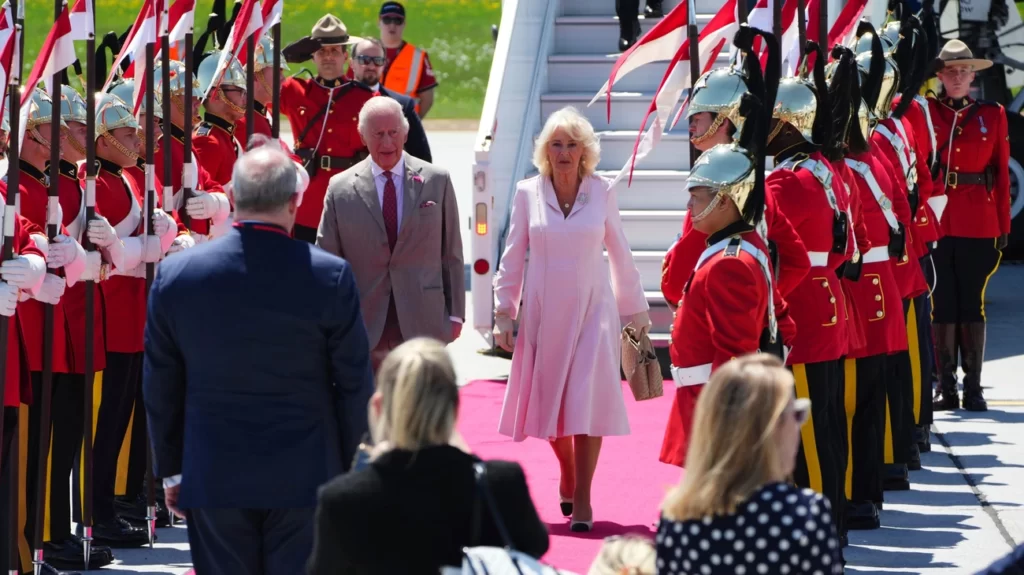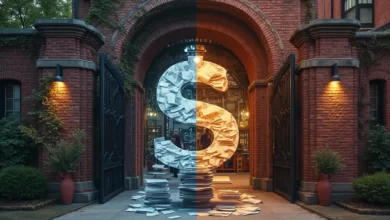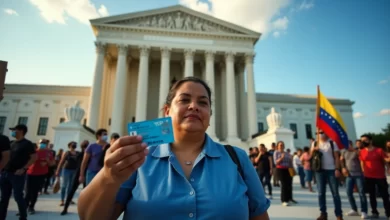King Charles Makes Historic Canada Visit Amid Trump Tensions

King Charles lands in Canada today, his first trip since taking the crown two years ago. He will make history as the first monarch to deliver the “Speech from the Throne” since Queen Elizabeth spoke to the Senate in 1977. This royal visit holds special diplomatic importance as tensions rise with the United States. Members of the Royal Canadian Dragoons, a 25-strong honor guard, welcomed the King and Queen at the airport as their meticulously planned tour began.
This visit comes at a delicate time for relations between Canada and America. Prime Minister Mark Carney won the April election on an anti-Trump platform and invited the King after President Trump’s controversial statements about making Canada the 51st U.S. state. Canadian pride has surged nationwide, and local businesses now display “Proudly Canadian” posters everywhere. The King plans to stand up for Canada’s independence in his upcoming speech, which he’ll deliver in both French and English to honor the country’s dual language heritage.
King Charles opens Canadian Parliament in rare royal gesture

The royal couple landed at Ottawa’s Macdonald-Cartier International Airport at 13:15 EST on Monday. A ceremonial welcome awaited them as their arrival launched a visit filled with constitutional symbolism and historical significance.
Ceremonial arrival at Ottawa airport
King Charles and Queen Camilla received a formal greeting from a distinguished reception committee after landing. The committee included Governor General Mary Simon, Prime Minister Mark Carney and his wife Diana Fox Carney. The welcome party also included prominent Indigenous leaders: Assembly of First Nations National Chief Cindy Woodhouse Nepinak, Inuit Tapiriit Kanatami President Natan Obed, and Métis National Council President Victoria Pruden. Members of the Royal Canadian Mounted Police and Canadian Armed Forces stood as an honor guard, highlighting this brief but momentous visit’s formal nature.
First monarch to deliver speech since 1977
Charles will deliver the Speech from the Throne in the Senate Chamber on Tuesday as the royal visit’s centerpiece. This represents only the third time in Canadian history that a reigning monarch has performed this constitutional duty. The last such occasion happened in October 1977, when Queen Elizabeth II read the speech during her Silver Jubilee tour. She had done so just once before, in October 1957 during her first visit as Queen.
Charles makes history as the first king to open a new session of parliament. A ceremonial horse-drawn carriage with a 28-horse escort will transport the monarch to the Senate. He will deliver the 25-minute speech, adding traditional pageantry to this rare constitutional event.
Charles serves as a nonpartisan head of state.
Role of the Governor General in the event
His Majesty King Charles III serves as King of Canada and Head of State in Canada’s constitutional framework, while the Governor General acts as his representative. The Governor General—currently Mary Simon—would typically deliver the throne speech, which outlines the government’s agenda for the new parliamentary session.
The king or his UK advisers do not write the speech, as Charles serves as a nonpartisan head of state. He will read exactly what Canada’s government puts before him. This showcases the delicate balance in Canada’s constitutional monarchy, where the sovereign follows Canadian ministers’ advice.
Queen Camilla will take part in a swearing-in ceremony to become a Canadian privy councilor. This further strengthens the royal connection to Canadian institutions during this historic parliamentary opening.
Trump’s annexation rhetoric prompts symbolic royal response

Prime Minister Mark Carney invited King Charles because of rising political tensions with the United States. Elected in April 2025 by running against Trump’s policies, Carney has become Canada’s defender against American threats.
Carney’s anti-Trump platform and invitation to Charles
The new Prime Minister, who previously led both the Bank of Canada and Bank of England, made standing up to Trump the life-blood of his campaign. Carney reached out to King Charles right after winning the election to show Canada’s independence under the constitution. This move sends a clear message to Canadians and the world about the country’s sovereign status and its British Crown ties rather than American influence.
Trump’s 51st state comments and public backlash
President Trump angered Canadians with his March 2025 rally statement that “Canada might as well become the 51st state—they do whatever we tell them anyway.” This comment, plus his threat of “total reciprocal tariffs” on Canadian goods, worried many people. Trump’s talk about American troops “guarding Canadian resources” scared both security experts and regular citizens.
Canadians showed their patriotic side in an unexpected way. “Proudly Canadian” posters popped up in stores everywhere, while social media movements like #WeAreNotThe51stState became the most important trending topics. Business groups that usually support America stepped up to defend Canada’s economic freedom.
Speech expected to assert Canadian sovereignty
King Charles must stay politically neutral, but royal insiders say his throne speech will stress Canada’s role as a “proud, independent realm.” The monarch will deliver this carefully written address from Carney’s government. This is a chance to show Canadian sovereignty through constitutional tradition.
The speech will probably talk about Canada’s historical ties to the Crown from before American independence. This creates a diplomatic balance to Trump’s annexation talk without directly criticizing the United States.
Canadians react to royal visit with mixed emotions
Canadians packed Ottawa’s streets to catch a glimpse of King Charles. Their reactions showed an array of public feelings about the monarchy during this crucial visit.
Warm welcome from local communities
Excited crowds showed up at Lansdowne Park even through scattered rain showers. Some people started singing “God Save the King” spontaneously. “Canada feels threatened and scared. It is very important he is here,” said Theresa McKnight from Mississauga. The King and Queen got an especially warm welcome during tree-planting events and meetings with local vendors. Charles even dropped a ceremonial hockey puck that made the crowd cheer.
Norman MacDonald watched from the crowd with pride. “Canada is not, obviously, for sale, and it’s not going to be bullied”, he said about worries over American influence.
Indigenous and immigrant views on monarchy
Several Indigenous leaders felt left out of official meetings with the monarch. Assembly of Manitoba Chiefs Grand Chief Kyra Wilson called this exclusion “a sign of disrespect”. Southern Chiefs Organization Grand Chief Jerry Daniels saw things differently. The visit was “a chance to promote the 32 nations represented by SCO”.
52% of immigrants support the monarchy compared to just 36% of Canadian-born citizens. The numbers tell a similar story for 47% of visible minorities who like the monarchy versus 37% of white Canadians.
Polls show indifference among majority
Recent polls point to changing attitudes about the monarchy. Support for keeping Canada’s constitutional monarchy has grown to 45%, while those wanting to abolish it fell to 39%. This marks a change from 2022 when 44% wanted to end monarchical ties.
Different regions see things differently. Quebec shows the strongest anti-monarchy feelings with 62% negative views. This compares to 42% in Ontario and 23% in Atlantic Canada. Older Canadians aged 55 and up (45%) support the monarchy more than younger people (36%).
Pollster Dan Arnold thinks this recent rise in monarchist support might show people want stability: “In the face of Trump and chaos and everything else, there’s a certain degree of stability that the institution and the King himself offer”.
Royal diplomacy walks tightrope between UK and Canada

King Charles faces a delicate diplomatic balance during his royal visit. He must protect Canadian sovereignty while keeping good relations with the United States. The ceremonial events mask a complex web of international relationships that the monarch carefully directs.
King’s past interactions with Trump and Zelensky
British Prime Minister Keir Starmer delivered a second state visit invitation to President Trump in February, which substantially expanded Charles’ diplomatic role. The King hosted Ukrainian President Volodymyr Zelensky at his Sandringham estate just days after Trump’s controversial Oval Office clash with him. This show of support for Ukraine made Trump feel “less special” about the King’s invitation.
Charles welcomed former Canadian Prime Minister Justin Trudeau to Sandringham in March. They talked about “matters of importance to Canadians — including, above all, Canada’s sovereign and independent future.” The King sent a clear message about Canada’s independence by meeting with a leader whom Trump calls “governor.”
Balancing UK’s foreign policy with Canadian identity
The King’s role as monarch of both nations creates unique challenges. “The King has long experience and great skill in walking that diplomatic tightrope,” a royal source said. “He’s held in high regard around the globe and across the political spectrum, with good relations with world leaders who understand his unique position.”
This dual role creates tension naturally. Canadian citizens expect their head of state to defend their sovereignty against Trump’s annexation rhetoric. The UK government needs Charles to keep positive relations with the American president. His constitutional limits prevent direct political statements, yet his actions speak volumes.
Camilla’s swearing-in as Canadian privy counselor
Queen Camilla took her oath as a member of the King’s Privy Council of Canada while wearing the diamond maple leaf brooch from the royal collection. This council advises the monarch on Canada’s important issues. The ceremony highlights the ongoing constitutional bond between Canada and the Crown, which matters even more given today’s sovereignty concerns.
Conclusion
Royal visit strengthens Canadian identity amid international tensions
King Charles’ historic visit marks a crucial moment in Canadian-British relations. A reigning monarch has delivered the Speech from the Throne for the first time since 1977. This reinforces Canada’s constitutional independence during a period of unprecedented diplomatic strain with the United States.
The royal visit’s timing carries significant weight. President Trump’s provocative “51st state” remarks triggered nationwide patriotic displays. Charles’ presence became a powerful symbol of Canadian sovereignty. Prime Minister Carney’s strategic invitation shows how traditional institutions can protect against modern threats, though public reaction varies across regional, generational, and cultural lines.
King Charles maintains a delicate diplomatic balance during his visit. His presence in Ottawa sends a clear message about Canada’s independent status, despite his constitutionally neutral position. The ceremonial elements reinforce the lasting constitutional relationship between Canada and the Crown, from the horse-drawn carriage to Queen Camilla’s swearing-in as privy councilor.
Recent polling data reveals a country grappling with its monarchical ties. Notwithstanding that, many Canadians see the monarchy as a stabilizing force in these uncertain global times. Norman MacDonald’s words at the welcoming ceremony resonated strongly: “Canada is not for sale, and it’s not going to be bullied.”
King Charles’ visit goes beyond mere ceremony. His presence stands as a powerful assertion of Canadian identity while external pressures threaten to undermine it. Questions about the monarchy’s relevance persist, yet this historic throne speech will be remembered as a defining moment when Canada reaffirmed its sovereignty through one of its oldest constitutional traditions.

